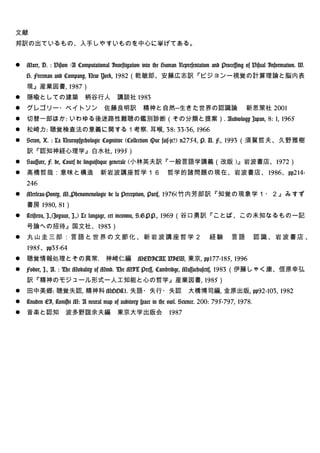1 of 1
Download to read offline

Ad
Recommended
薬剤性を疑う下眼瞼向き眼振 カルバマゼピン スルピリド 心因性めまい 半夏白朮天麻湯
薬剤性を疑う下眼瞼向き眼振 カルバマゼピン スルピリド 心因性めまい 半夏白朮天麻湯TeruKamogashira
?
薬剤性を疑う下眼瞼向き眼振 カルバマゼピン スルピリド 心因性めまい 半夏白朮天麻湯温度刺激検査における最大緩徐相速度と水温との関係 2023 第82回 日本めまい平衡医学会総会?学術講演会
温度刺激検査における最大緩徐相速度と水温との関係 2023 第82回 日本めまい平衡医学会総会?学術講演会TeruKamogashira
?
温度刺激検査における最大緩徐相速度と水温との関係 2023 第82回 日本めまい平衡医学会総会?学術講演会VEMPの背景筋活動電位の表示装置 2021年 第80回 日本めまい平衡医学会総会?学術講演会
VEMPの背景筋活動電位の表示装置 2021年 第80回 日本めまい平衡医学会総会?学術講演会TeruKamogashira
?
VEMPの背景筋活動電位の表示装置 2021年 第80回 日本めまい平衡医学会総会?学術講演会振動スピーカを利用した上肢?下肢振動覚の閾値測定の試み 2022年 第71回 日本医学検査学会
振動スピーカを利用した上肢?下肢振動覚の閾値測定の試み 2022年 第71回 日本医学検査学会TeruKamogashira
?
振動スピーカを利用した上肢?下肢振動覚の閾値測定の試み 2022年 第71回 日本医学検査学会前庭機能検査の結果と精神?心理面の評価尺度との関連性について 2022年 第81回 日本めまい平衡医学会 総会?学術講演会
前庭機能検査の結果と精神?心理面の評価尺度との関連性について 2022年 第81回 日本めまい平衡医学会 総会?学術講演会TeruKamogashira
?
前庭機能検査の結果と精神?心理面の評価尺度との関連性について 2022年 第81回 日本めまい平衡医学会 総会?学術講演会当院のめまい外来におけるSISI検査及びDPOAE検査の検討 2023年 第68回 日本聴覚医学会
当院のめまい外来におけるSISI検査及びDPOAE検査の検討 2023年 第68回 日本聴覚医学会TeruKamogashira
?
当院のめまい外来におけるSISI検査及びDPOAE検査の検討 2023年 第68回 日本聴覚医学会重心動揺検査データを用いた
機械学習による診断支援
重心動揺検査データを用いた
機械学習による診断支援TeruKamogashira
?
第80回日本めまい平衡医学会総会?学術講演会
ミニシンポジウム1 (11月11日)
めまいの遠隔診療?在宅医療の展望:ICT(情報伝達技術)とAI(人工知能)の活用Diagnosis Support by Machine Learning Using Posturography Data
Diagnosis Support by Machine Learning Using Posturography DataTeruKamogashira
?
Machine learning algorithms can help analyze posturography data to diagnose vestibular dysfunction. An evaluation of various algorithms found that gradient boosting had the best performance with an AUC of 0.90. While deep learning did not perform best, optimizing algorithm parameters is important. Larger, multi-institutional clinical datasets may improve machine learning's ability to accurately diagnose vestibular disorders from posturography data.小脳梗塞とめまい 2020年09月24日 抄読会
小脳梗塞とめまい 2020年09月24日 抄読会TeruKamogashira
?
Recent Advances in Cerebellar Ischemic Stroke Syndromes Causing Vertigo and Hearing Loss
Cerebellum. 2016 Dec;15(6):781-788.
Kim HA, Yi HA, Lee H础叠搁における滨贰颁60318-3及び滨贰颁60318-1準拠ヘッドフォンの比较
础叠搁における滨贰颁60318-3及び滨贰颁60318-1準拠ヘッドフォンの比较TeruKamogashira
?
2018 聴覚医学会
础叠搁における滨贰颁60318-3及び滨贰颁60318-1準拠ヘッドフォンの比较Responses from the trapezoid body in the Mongolian gerbil
Responses from the trapezoid body in the Mongolian gerbilTeruKamogashira
?
The study recorded responses from 80 fibers in the trapezoid body of the Mongolian gerbil. 26 fibers responded best to sounds in the ipsilateral ear and 54 to the contralateral ear. Many onset responses were observed, which is unusual compared to other mammals like cats. Onset responses occurred over a similar depth as primary-like responses. This suggests more diversity in response types of neurons in the gerbil anteroventral cochlear nucleus than in cats.Androgen receptors and gender-specific distribution of alkaline phosphatase i...
Androgen receptors and gender-specific distribution of alkaline phosphatase i...TeruKamogashira
?
Androgen receptors and gender-specific distribution of alkaline phosphatase in human thyroid cartilage.Auditory brain stem response to complex sounds a tutorial.
Auditory brain stem response to complex sounds a tutorial.TeruKamogashira
?
Auditory brain stem response to complex sounds a tutorial.More Related Content
More from TeruKamogashira (20)
重心動揺検査データを用いた
機械学習による診断支援
重心動揺検査データを用いた
機械学習による診断支援TeruKamogashira
?
第80回日本めまい平衡医学会総会?学術講演会
ミニシンポジウム1 (11月11日)
めまいの遠隔診療?在宅医療の展望:ICT(情報伝達技術)とAI(人工知能)の活用Diagnosis Support by Machine Learning Using Posturography Data
Diagnosis Support by Machine Learning Using Posturography DataTeruKamogashira
?
Machine learning algorithms can help analyze posturography data to diagnose vestibular dysfunction. An evaluation of various algorithms found that gradient boosting had the best performance with an AUC of 0.90. While deep learning did not perform best, optimizing algorithm parameters is important. Larger, multi-institutional clinical datasets may improve machine learning's ability to accurately diagnose vestibular disorders from posturography data.小脳梗塞とめまい 2020年09月24日 抄読会
小脳梗塞とめまい 2020年09月24日 抄読会TeruKamogashira
?
Recent Advances in Cerebellar Ischemic Stroke Syndromes Causing Vertigo and Hearing Loss
Cerebellum. 2016 Dec;15(6):781-788.
Kim HA, Yi HA, Lee H础叠搁における滨贰颁60318-3及び滨贰颁60318-1準拠ヘッドフォンの比较
础叠搁における滨贰颁60318-3及び滨贰颁60318-1準拠ヘッドフォンの比较TeruKamogashira
?
2018 聴覚医学会
础叠搁における滨贰颁60318-3及び滨贰颁60318-1準拠ヘッドフォンの比较Responses from the trapezoid body in the Mongolian gerbil
Responses from the trapezoid body in the Mongolian gerbilTeruKamogashira
?
The study recorded responses from 80 fibers in the trapezoid body of the Mongolian gerbil. 26 fibers responded best to sounds in the ipsilateral ear and 54 to the contralateral ear. Many onset responses were observed, which is unusual compared to other mammals like cats. Onset responses occurred over a similar depth as primary-like responses. This suggests more diversity in response types of neurons in the gerbil anteroventral cochlear nucleus than in cats.Androgen receptors and gender-specific distribution of alkaline phosphatase i...
Androgen receptors and gender-specific distribution of alkaline phosphatase i...TeruKamogashira
?
Androgen receptors and gender-specific distribution of alkaline phosphatase in human thyroid cartilage.Auditory brain stem response to complex sounds a tutorial.
Auditory brain stem response to complex sounds a tutorial.TeruKamogashira
?
Auditory brain stem response to complex sounds a tutorial.実験音声学 2003 文献
- 1. 文献 邦訳の出ているもの、入手しやすいものを中心に挙げてある。 ? Marr, D. : Vision -A Computational Investigation into the Human Representation and Processing of Visual Information. W. H. Freeman and Company, New York, 1982(乾敏郎、安藤広志訳『ビジョンー視覚の計算理論と脳内表 現』産業図書, 1987) ? 隠喩としての建築 柄谷行人 講談社 1983 ? —グレゴリー?ベイトソン 佐藤良明訳 精神と自然 生きた世界の認識論 新思策社 2001 ? 切替一郎ほか: いわゆる後迷路性難聴の鑑別診断(その分類と提案). Audiology Japan, 8: 1, 1965 ? 松崎力: 聴覚検査法の意義に関する1考察. 耳喉, 38: 33-36, 1966 ? Seron, X. : La Neuropsychologie Cognitive (Collection Que sais-je?) n2754, P. U. F., 1993(須賀哲夫、久野雅樹 訳『認知神経心理学』白水社, 1995) ? Saussure, F. de, Cours de linguistique generale (小林英夫訳『一般言語学講義(改版 )』岩波書店、1972) ? 高橋哲哉:意味と構造 新岩波講座哲学16 哲学的諸問題の現在、岩波書店、1986、pp214- 246 ? Merleau-Ponty, M.,Phenomenologie de la Perception, Paris, 1976(竹内芳郎訳『知覚の現象学1?2』みすず 書房 1980, 81) ? Kristeva, J.,(Joyaux, J.,) Le langage, cet inconnu, S.G.P.P., 1969(谷口勇訳『ことば、この未知なるものー記 号論への招待』国文社、1983) ? 丸山圭三郎:言語と世界の文節化、新岩波講座哲学2 経験 言語 認識、岩波書店 、 1985、pp35-64 ? 聴覚情報処理とその異常. 神崎仁編 MEDICAL VIEW, 東京, pp177-185, 1996 ? Fodor, J., A. : The Modality of Mind. The MIT Press, Cambridge, Massachusetts, 1983(伊藤しゃく康、信原幸弘 訳『精神のモジュール形式ー人工知能と心の哲学』産業図書, 1985) ? 田中美郷: 聴覚失認, 精神科 MOOK1. 失語?失行?失認 大橋博司編, 金原出版, pp92-103, 1982 ? Knuden EI, Konishi M: A neural map of auditory space in the owl. Science. 200: 795-797, 1978. ? 音楽と認知 波多野誼余夫編 東京大学出版会 1987